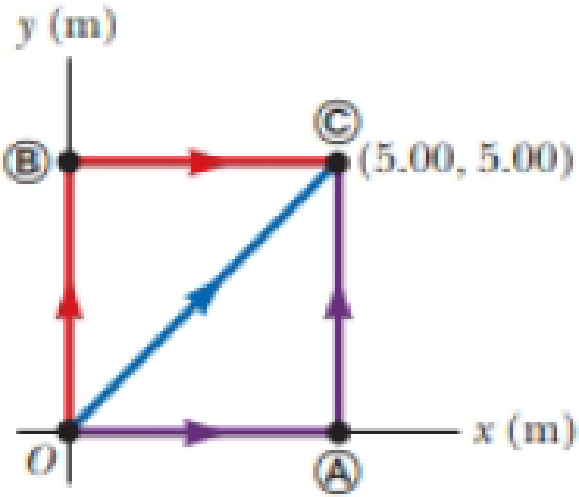
Concept explainers
A force acting on a particle moving in the xy plane is given by
Figure P7.31

(a)
The amount of work done by the force along the purple path.
Answer to Problem 33P
The work done by the force along the purple path is
Explanation of Solution
Given info: The coordinates of point (C) is
Along path OA the work is done is only in
Here,
Substitute
The value
Substitute
Thus, work done along OA is
Work done along AC is,
Substitute
The value of
Substitute
Thus, the work done along AC is
The work done along purple path is,
Substitute
Conclusion:
Therefore, the work done in the purple path is
(b)
The amount of work done by the force along the red path.
Answer to Problem 33P
The work done by the force along the red path is
Explanation of Solution
Given info: The coordinates of point (C) is
Work done along OB is,
Substitute
The value of
Substitute
Thus, the work done along the path OB is
Work done along BC is,
Substitute
Along path BC the value of
Substitute
Thus, the work done along the path OB is
The work done along red path is,
Substitute
Conclusion:
Therefore, the work done by the force along the red path is
(c)
The amount of work done by the force along the blue path.
Answer to Problem 33P
The work done by the force along the blue path is
Explanation of Solution
Given info: The coordinates of point (C) is
The work done along the blue path is,
Substitute
The value of
Conclusion:
Therefore, the work done by the force along the blue path is
(d)
Whether
Answer to Problem 33P
The force
Explanation of Solution
Given info: The coordinates of point (C) is
The work done by the force is non conservative in nature as a force is a conservative force if the work done is independent of the path the particle takes.
For the given case the work done in every case is different as the path changes for each of the cases. From the above calculation the work done by the force
Conclusion:
Therefore, the work done by force along every path is different hence it is a non conservative force in nature.
(e)
The reason for the force
Answer to Problem 33P
The work done along each path is different.
Explanation of Solution
Given info: The coordinates of point (C) is
The work done by the force
The work done by the given force
Conclusion:
Therefore, the force is non conservative in nature because work done along each path is different.
Want to see more full solutions like this?
Chapter 7 Solutions
Physics for Scientists and Engineers with Modern Physics
Additional Science Textbook Solutions
College Physics: A Strategic Approach (3rd Edition)
Introductory Chemistry (6th Edition)
Fundamentals Of Thermodynamics
Applications and Investigations in Earth Science (9th Edition)
Cosmic Perspective Fundamentals
- Please solve this problem correctly please and be sure to provide explanation on each step so I can understand what's been done thank you. (preferrably type out everything)arrow_forwardUse a calculation to determine how far the fishing boat is from the water level .Determine distance Yarrow_forwardNo chatgpt pls will upvote Already got wrong chatgpt answerarrow_forward
- 2. 1. Tube Rating Charts Name: Directions: For the given information state if the technique is safe or unsafe and why. 60 Hertz Stator Operation Effective Focal Spot Size- 0.6 mm Peak Kilovolts MA 2 150 140 130 120 110 100 90 80 70 2501 60 50 40 30 .01 .02 .04.06 .1 .2 .4.6 1 8 10 Maximum Exposure Time In Seconds Is an exposure of 80 kVp, 0.1 second and 200 mA within the limits of the single phase, 0.6 mm focal spot tube rating chart above? Is an exposure of 100 kVp, 0.9 second and 150 mA within the limits of the single phase, 0.6 mm focal spot tube rating chart above?arrow_forwardQ: You have a CO2 laser resonator (λ = 10.6 μm). It has two curved mirrors with R₁=10m, R2= 8m, and mirror separation /= 5m. Find: R2-10 m tl Z-O 12 R1-8 m 1. Confocal parameter. b= 21w2/2 =√1 (R1-1)(R2-1)(R1+R2-21)/R1+R2-21) 2. Beam waist at t₁ & t2- 3. Waist radius (wo). 4. 5. The radius of the laser beam outside the resonator and about 0.5m from R₂- Divergence angle. 6. Radius of curvature for phase front on the mirrors R₁ & R2-arrow_forwardNo chatgpt pls will upvotearrow_forward
 Physics for Scientists and Engineers: Foundations...PhysicsISBN:9781133939146Author:Katz, Debora M.Publisher:Cengage Learning
Physics for Scientists and Engineers: Foundations...PhysicsISBN:9781133939146Author:Katz, Debora M.Publisher:Cengage Learning Glencoe Physics: Principles and Problems, Student...PhysicsISBN:9780078807213Author:Paul W. ZitzewitzPublisher:Glencoe/McGraw-Hill
Glencoe Physics: Principles and Problems, Student...PhysicsISBN:9780078807213Author:Paul W. ZitzewitzPublisher:Glencoe/McGraw-Hill Principles of Physics: A Calculus-Based TextPhysicsISBN:9781133104261Author:Raymond A. Serway, John W. JewettPublisher:Cengage Learning
Principles of Physics: A Calculus-Based TextPhysicsISBN:9781133104261Author:Raymond A. Serway, John W. JewettPublisher:Cengage Learning Physics for Scientists and Engineers with Modern ...PhysicsISBN:9781337553292Author:Raymond A. Serway, John W. JewettPublisher:Cengage Learning
Physics for Scientists and Engineers with Modern ...PhysicsISBN:9781337553292Author:Raymond A. Serway, John W. JewettPublisher:Cengage Learning College PhysicsPhysicsISBN:9781938168000Author:Paul Peter Urone, Roger HinrichsPublisher:OpenStax College
College PhysicsPhysicsISBN:9781938168000Author:Paul Peter Urone, Roger HinrichsPublisher:OpenStax College University Physics Volume 1PhysicsISBN:9781938168277Author:William Moebs, Samuel J. Ling, Jeff SannyPublisher:OpenStax - Rice University
University Physics Volume 1PhysicsISBN:9781938168277Author:William Moebs, Samuel J. Ling, Jeff SannyPublisher:OpenStax - Rice University





